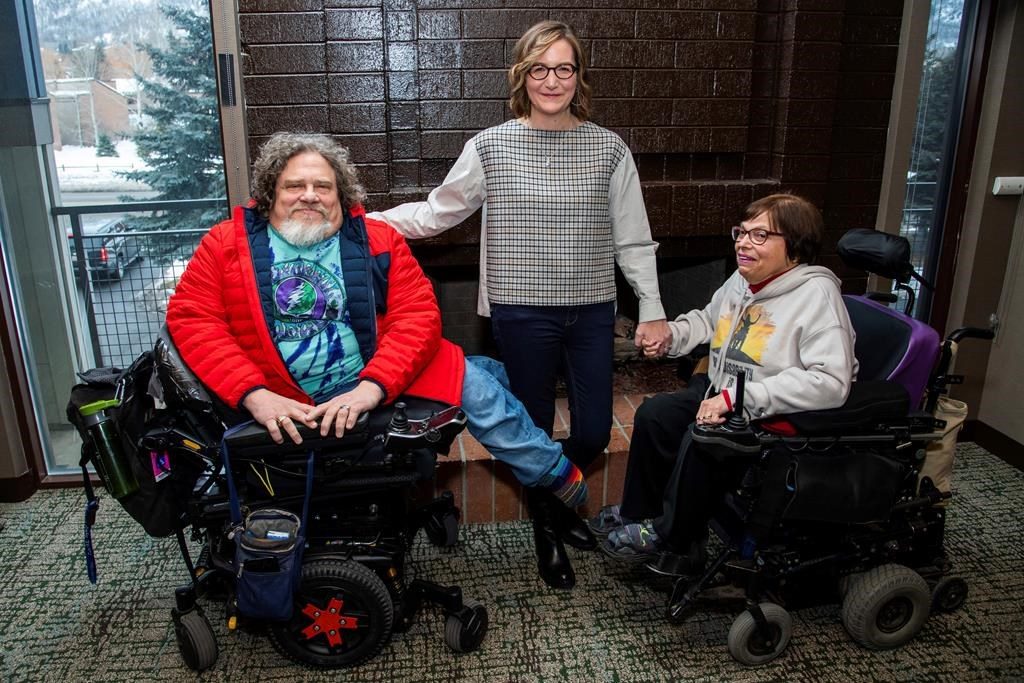Disability-rights movement takes spotlight at Sundance

PARK CITY, Utah — During the thunderous reception for the celebratory disability-rights documentary “Crip Camp” at the Sundance Film Festival, the loudest response came when disability advocate Judith Heumann, one of the film’s chief personalities, wheeled on stage.
“It was as loud as a jet airplane taking off,” Jim LeBrecht, who co-directed the film with Nicole Newnham, said the morning after the film’s premiere.
Even on a night when Taylor Swift’s “Miss Americana” also debuted, “Crip Camp” caused a stir at the Park City festival.
Advertisement
The movie begins as a nostalgic remembrance of Camp Jened, a summer camp for teens with disabilities in upstate New York that, before shuttering in 1977, was run by hippies with much of the spirit of nearby Woodstock.
For camp attendees who came with polio, cerebral palsy and other disabilities, Jened was a utopia of acceptance and community. And it helped spark a movement. “Crip Camp” recounts how many of those who went to Jened — including Heumann, a polio survivor, and LeBrecht, born with spina bifida — went on to play prominent roles in the disability-rights movement, culminating in 1990’s Americans with Disabilities Act.
“Crip Camp” unfolds as a broader chronicle of a decadeslong fight for civil rights that has received less attention than other 20th century struggles for equity. The makers of “Crip Camp,” the second film backed by Barack and Michelle Obama’s Higher Ground Productions, believe the film can be a galvanizing moment.
“I hope this film will ignite other stories,” said Heumann, whose lifetime of advocacy includes successfully suing to become the first wheelchair-using teacher in New York, leading a historic 1977 sit-in and serving as a special adviser on disability rights at the State Department. “These stories are out there.”
But by any metric, the stories of people with disabilities are among the least represented in film and television. Last year, USC Annenberg’s annual inequality report found that, of the 4,445 characters in the most popular movies of 2018, just 1.6% were shown with a disability. U.S. census figures estimate 27.2% of Americans have some form of disability.
Advertisement
A 2019 study by the Ruderman Family Foundation found that about half of U.S. households favour authentic portrayals of actors with disabilities. Yet Hollywood, where villains are still regularly signalled by deformity, has a long history of unfavourable, stereotyped or inauthentic depictions of disability.
“We’ve learned so much about people around us from film and television, and if what you’re getting is just purely stories about people having tragedies — in the case of ‘Million Dollar Baby’: ‘Please kill me. Please, please.’ — or the kind of super, overcoming story that we sometimes call the ‘super-crip’ story, neither of these people are relatable and neither are reflective of the community in general,” said LeBrecht, a Berkeley, California-based sound designer.
Heumann, LeBrecht and Newnham hope “Crip Camp” encourages conversations about how movies and media have fostered false impressions of people with disabilities.
“There needs to be a fundamental altering in what goes on in media,” said Heumann, who has written about disability representation for the Ford Foundation. “At Sundance, I’m in a room with hundreds and hundreds of progressives who pride themselves on being progressives, who pride themselves on supporting diversity. And the number of people who say — and it’s not the first time I’ve heard this — ‘We didn’t know.’”
“Crip Camp” has already effected some change. LeBrecht, having attended previous Sundance festivals, urged the festival to improve accessibility. He previously was unable to go into the festival’s filmmakers lounge because it didn’t have an elevator. Sundance recently announced that it would, with the Ruderman Family Foundation, provide more resources for attendees with disabilities and program more movies featuring people with disabilities.
Advertisement
Newnham says a planned campaign around the film’s release later this year on Netflix is intended to further prompt discussion. The change needed goes much deeper than accessibility, she said. It’s about reprogramming how the non-disabled think of people with disabilities.
“We’re excited that the film seems to be being seen as a celebration of disability culture and pride, and we feel that can go a long way, too,” said the Emmy-winning documentary producer and director.
A veteran of the ups and downs of activism, Heumann knows change comes slowly. And she remains frustrated at the movement’s lack of progress.
“When I’m truthful, I feel very angry about what’s gone on,” Heumann said.
“We’re frequently having to temper our thoughts and our comments because people don’t necessarily want to hear them,” she added. “People have to be in a certain head space to be willing to have difficult discussions.”
Advertisement
But “Crip Camp,” she granted, could be a new beginning for how disability is understood on screen, and off.
“Whoever we are,” Heumann said, “we have the ability to make change.”
___
Follow AP Film Writer Jake Coyle on Twitter at http://twitter.com/jakecoyleAP
Advertisement
Jake Coyle, The Associated Press